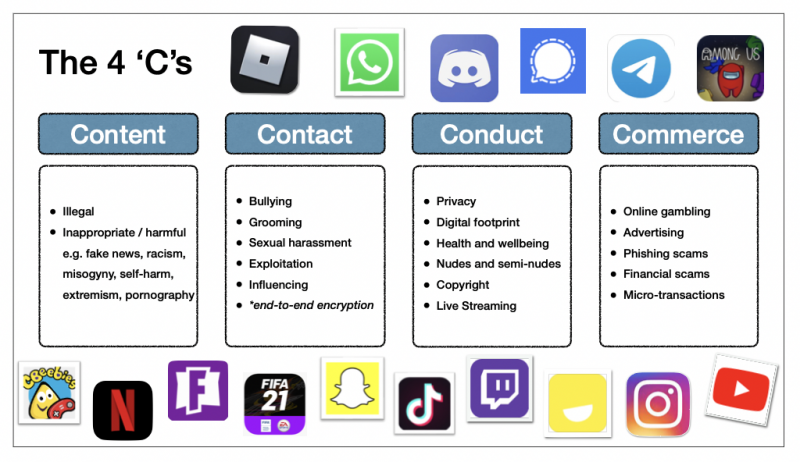Learning in the Online world
Online Safety Click here if you believe your child is at risk online! Click Here to report harmful content online.
What is Online Safety?
Online Safety means…
· knowing about potential threats when you are online;
· knowing what you can and cannot (legally) do when you are online; and
· knowing how to protect yourself from some of the risks that are involved in using the internet.
Online Safety covers ‘All fixed and mobile technologies that children and young people may encounter, now and in the future, which allow them access to content and communications that could raise issues or pose risks to their wellbeing and safety’.
Ways in which our children use and access the Online world within Ormiston Cliff Park Primary Academy.
All children at Ormiston Cliff Park Primary Academy have an academy Microsoft email address which allows them to engage with technology systems on site including those needed by the children to access remote learning for the academy. These email addresses allow our children to access Microsoft Teams, and log onto computers and tablets but this capability only allows our pupils to communicate within our Academy systems that are monitored. Communication with accounts outside of our organisation is blocked.
Online technology in the form of tablets and laptops is primarily used by the children as:
· Tool for Research
· Tool for development of learning in computing
· reinforcement and practice of skills in computing;
· practice of skills in other subject areas in support of curriculum learning.
Pupil access the online world in support of learning using laptops and tablets particularly via the online platforms of
· TT Rockstars,
· Sumdog
· Accelerated reader,
· phonics play
Filtering and Monitoring at Ormiston Cliff Park Primary Academy
To enable safe online browsing at Ormiston Cliff Park Primary Academy we use a filtering system provided by Netsweeper The web filter scans the copy, content and context of every page for unwanted material and blocks access to anything inappropriate to ensure that harmful content is out of reach.
The main focus of the filtering system are sites containing child sexual abuse, terrorism and adult content but are not limited to these. At the same time the filtering system does not over
block and does not lead to unreasonable restrictions as to what children can be taught with regards to online teaching and safeguarding.
The filtering system described above also monitors everything staff and pupils type either into a web browser.
Alerts are sent to the Designated Safeguarding Leads when users type content that is cause for concern. These events lead to site blocking. Alerts are then reviewed quickly by the Designated Safeguarding lead who is also the online safety lead to determine what further action needs to be taken. Discussions with staff and children will then take place to determine risk, review access and challenge behaviour where appropriate.
Online safety process and discussions start from the premise of assessing and protecting children aginst online risk using the principles below:
Classification Of Online Risk – The 4 Cs
The CO:RE 4 Cs classification recognises that online risks arise when a child:
· engages with and/or is exposed to potentially harmful CONTENT e.g pornography, fake news, racism, misogyny, self-harm, suicide, anti-Semitism, radicalisation and extremism.
· experiences and/or is targeted by potentially harmful CONTACT e.g. being subjected to harmful online interaction with other users; peer-to-peer pressure, commercial advertising and adults pretending to be a child online to groom or exploit them.
· witnesses, participates in and/or is a victim of potentially harmful CONDUCT e.g. being subjected to harmful online interaction with other users; peer-to-peer pressure, commercial advertising and adults
pretending to be a child online to groom or exploit them.
· has access and is exposed to potentially harmful COMMERCE e.g. Online gambling, inappropriate advertising, phishing and financial scams.
Continuing the Learning Journey…
Where your child is unable to attend the Academy due to the need of isolation eg. due to COVID 19 we want to ensure you have access to learning from home should you need to follow Government guidelines.
Where children are not ill (COVID positive) but are at home following the isolation requirements we would ask that learning continues using the bank of resources provided through link on this page.
All children should be in the Academy unless needing to follow guidelines for isolation.
We have uploaded a large bank of resources for you to access that are at an age appropriate level.
Click on your year group below to see more
There are also many excellent online resources that have been made available by education providers too. Click the links below to access their incredible banks of resources.
In accordance with statutory guidelines, the Department for Education (DfE) ask that schools provide information on remote education provision. It is aligned to the expectations for remote education, to which schools must have regard under the temporary continuity direction given by the Secretary of State for Education. This information is intended to provide clarity and transparency to pupils, parents and carers about what to expect from remote education if local health restrictions require them to remain at home and/or if they need to self-isolate.
